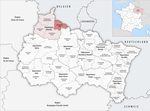Battle of La Marfée
1641 in FranceBattles in Grand EstBattles involving FranceBattles involving the Holy Roman EmpireBattles of the Franco-Spanish War (1635–1659) ... and 4 more
Battles of the Thirty Years' WarConflicts in 1641History of Ardennes (department)Interlanguage link template existing link

The Battle of La Marfée, also known as the Battle of Sedan, took place on 6 July 1641, during the 1635 to 1659 Franco-Spanish War, a related conflict of the Thirty Years War. It was fought near Sedan, France, on 6 July 1641, between a French army led by the Duke of Châtillon, and an Imperial-Spanish army commanded by Guillaume de Lamboy, supported by French rebels led by the Comte de Soissons and Frédéric-Maurice de La Tour d'Auvergne, Duke of Bouillon. The French army collapsed, but Soissons was killed in the closing moments, allegedly by using a loaded pistol to open his helmet, and the opportunity quickly passed.
Excerpt from the Wikipedia article Battle of La Marfée (License: CC BY-SA 3.0, Authors, Images).Battle of La Marfée
Avenue de la Marck, Sedan
Geographical coordinates (GPS) Address Nearby Places Show on map
Geographical coordinates (GPS)
| Latitude | Longitude |
|---|---|
| N 49.7025 ° | E 4.9411 ° |
Address
Avenue de la Marck
08200 Sedan
Grand Est, France
Open on Google Maps








